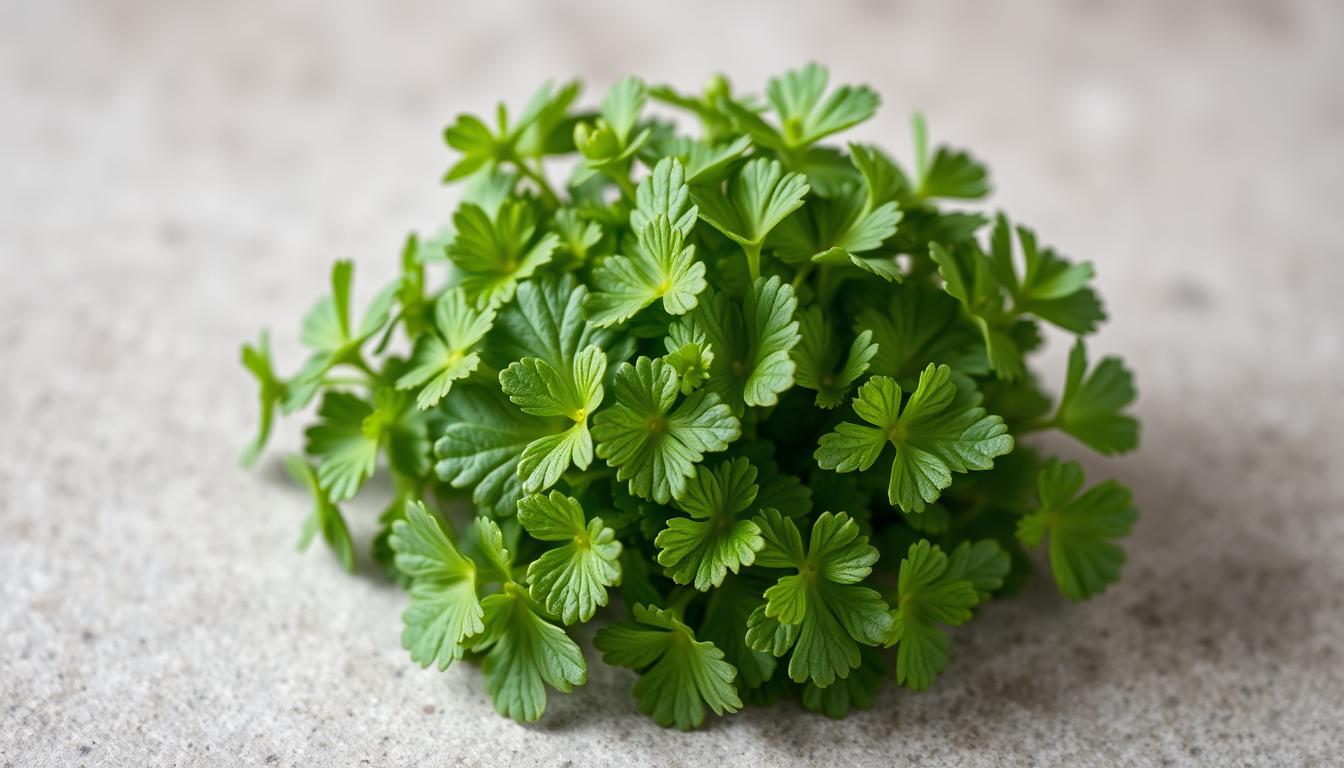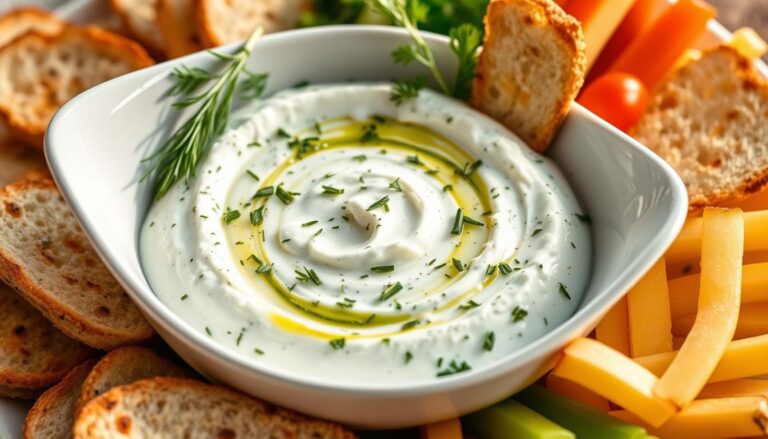Salad Burnet A Versatile Herb for Your Dishes
Looking to spice up your meals? Want to add a fresh twist? Salad Burnet is a hidden gem that can do just that. It brings a unique cucumber-like taste to your food.

This herb is great in many dishes, like salads, soups, and as a garnish. It’s packed with vitamins A and C, calcium, and iron. Adding salad burnet to your recipes can introduce new flavors and health benefits.
Key Takeaways
- Adds a fresh cucumber-like flavor to dishes
- Rich in vitamins A and C, calcium, and iron
- Versatile uses in salads, soups, and as a garnish
- Enhances nutritional value of meals
- Easy to incorporate into various recipes
Discovering the Cucumber-Flavored Charm of Herbs
Exploring herbs, you’ll find Salad Burnet’s charm. It has small, deeply serrated leaves and tastes like cucumber. This makes it great for many dishes.
What Makes Salad Burnet Special
Salad Burnet’s flavor is its main charm. The cucumber-flavored charm adds a refreshing twist. It’s perfect for salads, soups, sandwiches, and eggs.
Why This Herb Deserves a Place in Your Kitchen
Adding Salad Burnet to your cooking boosts flavor and health. The salad burnet benefits include nutrition and medicinal uses. It’s a great addition to your kitchen.
Understanding Salad Burnet’s value lets you use it in new ways. Enjoy its taste and health perks in your cooking.
What Is Salad Burnet?
Salad Burnet has a unique look and tastes like cucumber. It’s a great herb to add to your meals. It brings a special flavor and has health perks too.
Botanical Characteristics and Identification
Salad Burnet stands out with its serrated and lobed leaves. Its greenish, round flowers on tall stems are also key to identifying it.
Appearance and Growth Habits
Salad Burnet grows tall, making it easy to spot in gardens or herb collections. Its height is a big part of its charm.

Salad Burnet is special but also part of a bigger family of herbs. Knowing its relatives helps you use it better in cooking.
Flavor Profile and Aromatic Properties
Salad Burnet tastes like cucumber, making it great for salads. Its scent is subtle but adds a lot to dishes.
Learning about Salad Burnet’s look, growth, and taste helps you see its value in cooking. It also highlights its health benefits.
The Rich History of Salad Burnet Through the Ages
Salad Burnet has a long history across many cultures. It’s been important in both food and medicine. Its unique taste makes it a favorite in many dishes.
Ancient Uses and Historical Significance
People have used Salad Burnet for ages for health and taste. Ancient herbalists prized it for treating wounds and stomach problems. It’s also a key part of traditional European cooking, adding flavor to salads and soups.
“Salad Burnet was used by our ancestors not just as a flavor enhancer but also as a remedy for numerous health issues, showcasing its importance in traditional medicine.”
Cultural Importance Across Different Cuisines
Salad Burnet is loved worldwide for its fresh taste. Today, it’s in salads, as a garnish, and in herbal teas. It brings freshness and depth to modern dishes.
| Culture | Use of Salad Burnet |
|---|---|
| European | Traditionally used in salads, soups, and as a medicinal herb. |
| Modern Cuisine | Used as a garnish, in salads, and for herbal teas. |
Knowing Salad Burnet’s history and cultural role helps us see its value today. It’s a treasure in both old and new cooking.
Growing Your Own Salad Burnet Plant
Growing your own Salad Burnet plant is rewarding. It gives you fresh herbs right in your garden. First, learn the best conditions for Salad Burnet to grow well.
Ideal Growing Conditions and Requirements
Salad Burnet likes well-drained soil and partial sun. This makes it easy to grow in many gardens.
Soil Preferences
For the best growth, Salad Burnet needs soil that drains well. This prevents waterlogged soil and root rot. Adding compost and perlite helps with drainage and makes the soil richer.
Light and Temperature Needs
Salad Burnet does well in partial sun to full sun. It likes cooler temperatures, between 60°F to 70°F (15°C to 21°C). This makes it perfect for spring or fall gardens.
Propagation Methods and Techniques
Salad Burnet can be grown through division or seed. Division is easy for grown plants, but seeding lets you control spacing better.
| Propagation Method | Advantages | Disadvantages |
|---|---|---|
| Division | Easy for established plants, quick results | Limited control over spacing |
| Seeding | Allows for precise spacing, cost-effective | Requires more time to establish |
Common Pests and Diseases to Watch For
Salad Burnet is mostly hardy but can get pests like aphids and slugs. Watch for them and use organic pest control. Root rot can be avoided by ensuring good drainage and not overwatering.

Essential Salad Burnet Care Tips
Caring for Salad Burnet is easy and important for its health and taste. Knowing its basic needs is key to making it thrive.
Watering and Fertilization Guidelines
Salad Burnet needs steady moisture, especially when it’s young. Water it often, but don’t overdo it to avoid root rot. A good soil mix helps keep the soil from getting too wet.
Fertilizing is also important. Use a balanced fertilizer during the growing season to help it grow well. Give it compost or well-rotted manure now and then as it’s a perennial herb.

Pruning and Maintenance Strategies
Pruning regularly keeps your Salad Burnet looking good and growing bushy. Take out any dead or damaged leaves to stop diseases. Pruning also encourages new growth for cooking.
Also, keep the area around your Salad Burnet weed-free. Weeds take nutrients and water from your plant. Divide and replant your Salad Burnet now and then to keep it healthy and not too crowded.
By following these care tips, you’ll have a happy and productive Salad Burnet plant.
Harvesting and Preserving Salad Burnet
To enjoy Salad Burnet all year, learn how to harvest and preserve it. This way, you can add its unique taste to salads and soups.
When and How to Harvest
Harvest Salad Burnet in late spring to early summer. Its leaves are tender and flavorful then. Use scissors or your fingers to cut off the leaves without harming the plant. This helps the plant grow more leaves for you.
Storage and Preservation Methods
There are several ways to keep Salad Burnet fresh all year. Drying and freezing are the best methods.
Drying Techniques
Drying is easy. Tie the stems in small bunches and hang them in a warm, dark place. Once dry, store the leaves in airtight containers to keep their flavor and aroma.
Freezing Options
Freezing is another great way to preserve Salad Burnet. Chop the leaves and put them in ice cube trays with water or olive oil. After they freeze, move the cubes to freezer bags for easy use in cooking.

7 Remarkable Health Benefits of Salad Burnet
Salad Burnet is packed with nutrients, making it great for your health. It’s not just tasty in many dishes but also boosts your well-being. Adding it to your meals can make your diet healthier.
Nutritional Composition and Value
Salad Burnet is full of vitamins A and C, calcium, and iron. It’s a nutritious choice for any meal. Plus, it’s low in calories, perfect for those watching their weight.
Traditional Medicinal Applications
For ages, Salad Burnet has helped with digestion and reduced inflammation. Its healing powers have been known for centuries. It’s used for treating wounds and easing symptoms of many illnesses. Its anti-inflammatory properties make it a natural remedy for many health problems.
Modern Research on Health Properties
Recent studies are exploring Salad Burnet’s health benefits. They show it might have antioxidant effects. As research goes on, we’ll learn more about its health perks. This will make it even more valuable in a healthy diet.
10 Creative Ways to Use Salad Burnet in Your Cooking
Discover the many uses of salad burnet and add a fresh twist to your cooking. This versatile herb can be incorporated into various dishes, enhancing their flavor and nutritional value.
Salads and Fresh Preparations
Salad burnet is a great addition to green salads, pasta salads, and fruit salads. Its cucumber-like flavor pairs well with fresh vegetables and fruits. You can also use it as a garnish for sandwiches and wraps.
Cooked Dishes and Warm Applications
Salad burnet can be used in soups, stews, and casseroles, adding depth and warmth to these dishes. It can also be sautéed with garlic as a side dish or used as a topping for roasted vegetables.
Beverages and Infusions
Infuse salad burnet into beverages like tea, cocktails, or infused water for a refreshing twist. Its flavor complements citrus and herbal notes well.
Preserves and Condiments
Make preserves and condiments like salad burnet jelly, herb butter, or salad burnet vinegar to add a unique flavor to your dishes. These can be used as gifts or stored for later use.
By incorporating salad burnet into your cooking, you can explore new flavors and enhance your culinary creations. Whether you’re making a simple salad or a complex dish, salad burnet is a versatile ingredient that can elevate your cooking.
5 Delicious Salad Burnet Recipes to Try Today
Discover the tasty world of Salad Burnet with our top picks. This herb is great in salads, soups, sauces, and drinks.
Salad Burnet Butter
Begin with a compound butter. Mix softened butter with chopped Salad Burnet, lemon juice, and salt. It’s perfect for bread or grilled meats.
Cucumber and Salad Burnet Soup
Blend cucumber, Salad Burnet, garlic, and yogurt for a cool soup. It’s great for hot days as a starter or light lunch.
Salad Burnet Vinaigrette
Whip up a tasty vinaigrette. Mix Salad Burnet with olive oil, vinegar, mustard, and honey. It’s awesome on salads or for veggies.
Herb-Crusted Fish with Salad Burnet
Add flavor to fish with Salad Burnet. Mix it with breadcrumbs, parmesan, and lemon zest. Coat your fish and bake.
Salad Burnet Tea and Cocktails
Try Salad Burnet in drinks. Steep the leaves for tea or add it to cocktails for a twist.
Conclusion: Embracing Salad Burnet in Your Culinary Journey
Adding Salad Burnet to your cooking can make your dishes taste better and be healthier. This herb has a unique flavor that’s like cucumber. It can make many recipes, like salads, soups, drinks, and preserves, even better.
Salad Burnet can do a lot in your kitchen. It can add fresh taste to salads and soups. You can also use it to make herb-crusted fish and infused drinks. Its long history, health benefits, and many uses make it a great choice for any cook.
As you try out Salad Burnet, you’ll find new ways to use it in your cooking. It’s perfect for both experienced chefs and home cooks looking to try something new. Salad Burnet will add a fresh and tasty twist to your favorite dishes.
FAQ
What is Salad Burnet used for in cooking?
Salad Burnet adds a unique flavor to dishes like salads, soups, and sauces. It tastes like cucumber and smells refreshing.
How do I grow Salad Burnet in my garden?
To grow Salad Burnet, pick a spot with well-drained soil and some shade. You can start it from division or seeds. Keep it watered and fertilized regularly.
What are the health benefits of consuming Salad Burnet?
Salad Burnet is full of antioxidants. It’s good for your digestive health and can help reduce inflammation. Research also shows it might have anti-inflammatory and antimicrobial effects.
How do I harvest and preserve Salad Burnet?
Pick Salad Burnet leaves and stems when they’re young and soft. You can dry, freeze, or infuse it in vinegar or oil. This way, you can enjoy its taste and health benefits all year.
Can I use Salad Burnet in beverages?
Yes, Salad Burnet is great for making teas, infusions, and cocktails. Its cucumber-like taste adds a refreshing touch to drinks.
How do I care for my Salad Burnet plant?
Keep your Salad Burnet plant healthy by watering it often and fertilizing it during the growing season. Prune it to keep its shape and encourage new growth.
Is Salad Burnet related to other herbs?
Salad Burnet belongs to the Rosaceae family, which includes roses and strawberries. It has a unique flavor and aroma. While it’s different from other herbs, it shares some uses with mint and basil in cooking.
Can I use Salad Burnet in cooked dishes?
Yes, Salad Burnet is great in cooked dishes like soups, stews, and sauces. Add it towards the end of cooking to preserve its flavor. It’s a versatile ingredient for many recipes.







